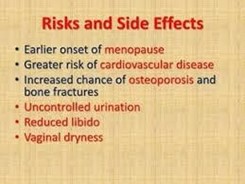A nurse is planning teaching for a client following a total abdominal hysterectomy.Which of the following expected manifestations should the nurse include in the teaching?
Weight loss
Increased libido
Decreased menstrual bleeding
vaginal dryness
The Correct Answer is D
Choice A rationale:
Weight loss is not typically an expected manifestation following a total abdominal hysterectomy.
Choice B rationale:
Increased libido is not necessarily an expected manifestation following a total abdominal hysterectomy.
Choice C rationale:
Decreased menstrual bleeding is expected, as the uterus has been removed.
Choice D rationale:
Vaginal dryness is an expected manifestation following a total abdominal hysterectomy due to the removal of the ovaries, which produce hormones that contribute to vaginal lubrication.

Nursing Test Bank
Naxlex Comprehensive Predictor Exams
Related Questions
Correct Answer is A
Explanation
Choice A rationale:
The client is experiencing signs of an allergic reaction or anaphylaxis, which can be life-threatening. The rapid response team should be called to provide immediate medical assistance.
Choice B rationale:
Intubation is not the immediate priority. Addressing the allergic reaction and ensuring the client's airway, breathing, and circulation are the first steps.
Choice C rationale:
Obtaining an arterial blood gas (ABG) level is not the priority when the client is experiencing respiratory distress and facial swelling.
Choice D rationale:
Administering diphenhydramine may be part of the treatment plan, but the immediate priority is to call for emergency assistance to manage the allergic reaction.
Correct Answer is D
Explanation
Choice A rationale:
Asking why the client enjoys gambling doesn't address the underlying issues of gambling disorder.
Choice B rationale:
Instructing the client to apologize to their family is judgmental and not therapeutic.
Choice C rationale:
Assuming the family's emotions and feelings is not appropriate and may not be accurate.
Choice D rationale:
Asking about the client's first experience with gambling can help uncover triggers and patterns related to the disorder, which can be useful for treatment.
Whether you are a student looking to ace your exams or a practicing nurse seeking to enhance your expertise , our nursing education contents will empower you with the confidence and competence to make a difference in the lives of patients and become a respected leader in the healthcare field.
Visit Naxlex, invest in your future and unlock endless possibilities with our unparalleled nursing education contents today
Report Wrong Answer on the Current Question
Do you disagree with the answer? If yes, what is your expected answer? Explain.
Kindly be descriptive with the issue you are facing.
